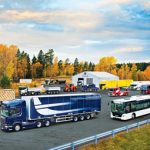Seeing the forest for the trees

The timber transport industry is well-known for its extreme operating conditions, payload challenges and superb truck drivers … JACO DE KLERK speaks to Brian Hunt, managing director of Timber Logistics Services, to shine the spotlight on this sector
How has the industry changed over the past 10 years?
Hunt: The timber transport industry has experienced a number of significant changes and innovations over the last ten years.
These include the implementation of the Road Transport Management System (RTMS) – an industry-led, self-regulation programme, focusing initially on payload management and reducing overloads. Subsequently, other key areas of attention covered by RTMS include safety and vehicle maintenance.
Smart Trucks were also introduced. These are specialised, abnormal-load logging units that enable contract-specific tonnages of raw timber to be delivered to paper and saw mills using fewer vehicles. This cuts operating and fuel costs, harmful emissions, road damage and traffic congestion. These units also comply with performance-based standards (PBS) specifications that ensure abnormal length/load vehicles are stable and safe.
Further development and refinement of these trucks has also taken place in the industry.
What trends or new developments, within the timber transport industry, are you most excited about?
Hunt: Probably the most exciting development has been the introduction and use of Smart Trucks. The industry pioneered the use of these units, initially as a pilot project using two rigs. Subsequently, the first commercial fleet of 15 rigs, each with an overall length of almost 27 m, were introduced into service in 2009, by Timber Logistics Services.
Modifications to these rigs have seen the length being reduced to 25,2 m. It has been possible to achieve payloads in excess of 45 tonnes on a sustainable basis using these rigs, compared to the average payload of 38 tonnes, achieved with standard 22 m rigs.
In August 2013, a new Smart Truck with an overall length of 23,2 m was introduced. This rig, designed to transport six-metre logs, has been in service for some six months, has travelled in excess of 150 000 km and has consistently achieved payloads of more than 46 tonnes. Fuel consumption has been some eight percent lower than figures recorded for the original Smart Truck fleet.
What unique challenges does the forestry transport industry face, and how are you overcoming these?
Hunt: There are three unique challenges:
• First, payload management. It must be appreciated that there are variables, in terms of age and timber species, impacting on the mass of a transported log. We are not transporting bags of cement or flour with a known mass. For this reason, on-board weighing systems form a vital part of equipment on a timber rig. Maintenance of the system and all airlines fitted to the rig, as well as driver training, are critical. Drivers not only have to be trained in the use of the weighing system, but also in identifying problems and compensating for these when assessing the vehicle’s gross vehicle mass – overloads are a definite no-no. Regular calibration of the onboard weighing system is essential as well.
• Second, variable road conditions. Timber rigs travel on a variety of road surfaces, impacting on tyre selection and abnormal wear and tear. Maintenance programmes have been developed and implemented to compensate.
• Third, driving experience in the industry. Apart from the challenges of driving on potholed secondary roads, gravel roads and forestry roads, timber truck drivers are regularly faced with weather extremes and the difficulties encountered in confined space operations – both at loading zones and in wood mill yards.
Drivers, who lack experience with these varying conditions and circumstances, will cause damage to the rigs and will frequently be unable to extricate their vehicles from tricky situations. Special training modules within a company’s training programme must be developed to complement normal driving skills.
What strain do your operations place on your equipment?
Hunt: It must be appreciated that a timber truck and trailer encounters conditions that will test the rig to its fullest extent. As a general rule, the loaded trip from the forest to the mill is downhill, resulting in extensive use of the retarder and braking systems.
The differential lock is also a feature that is probably utilised to a far greater degree than in normal road-haul operations, particularly during the rainy season. And the need to optimise payload has led to the development of lightweight timber trailers. The downside is that operational stresses must be monitored.
What modifications do you make to your vehicles and trailers to compensate for these strains? And how do “normal” trucks differ from those that are used to transport timber?
Hunt: Although timber trailers are specifically designed for this type of operation, standard trucks supplied by original equipment manufacturers require a number of modifications. The skeletal nature of the body necessitates additional protection fitments and modifications.
Reinforced protection is required for fuel tanks and battery boxes and, where possible, tanks fitted on the outside of the chassis need to be relocated to the inside of the chassis. All components inside the chassis are protected by belting fitted from the headboard to the end of the chassis. Plating is required over the tow-hitch to provide protection for the electrical lines.
What does the future hold for the industry?
Hunt: The timber transport industry has pioneered the RTMS concept and the introduction of Smart Trucks in South Africa. I believe that the foundations have been laid for the wider use of Smart Trucks, with the introduction of new-generation rigs designed for specific applications – leading to reduced carbon emissions, a reduction in the number of trucks on the road and a reduction in the cost of logistics to the customer.
Increased acceptance, together with improved application and monitoring of RTMS principles and policies, will result in improved safety and favourable perceptions of the timber transport industry by the public in general.
What parting thought would you like to leave us with?
Hunt: Safety is generally of paramount importance in the transport industry, and certainly in the timber transport sector. The safety programmes followed by Timber Logistics Services form an integral part of our management programme, with particular focus on key care issues. These include driver training, diver health and vehicle maintenance, as well as vehicle replacement policies.
The latter ensures that no vehicle is operated beyond its reasonable life – in our case this means that all trucks are replaced after three years or 600 000 km. Trailers are totally reconditioned at
600 000 km and withdrawn from service at 1 200 000 km.
The success of any programme is best measured by results and, in this regard, the safety achievements can best be illustrated by the fact that Timber Logistics Services has exceeded three million man hours since any time has been lost owing to injury.
Published by
Focus on Transport
focusmagsa




